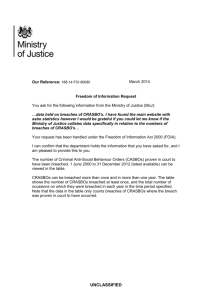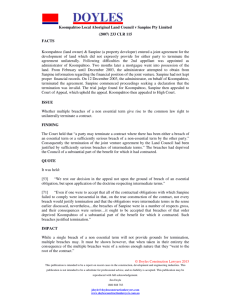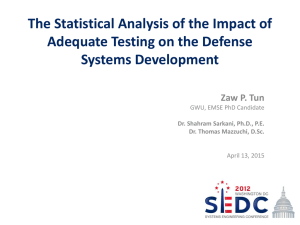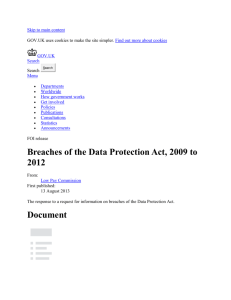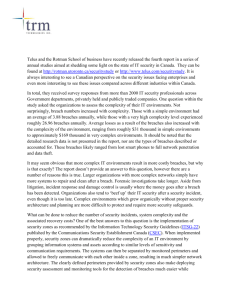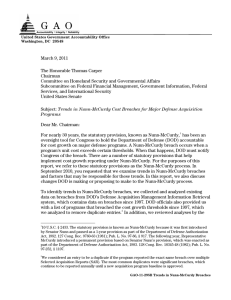GAO
advertisement
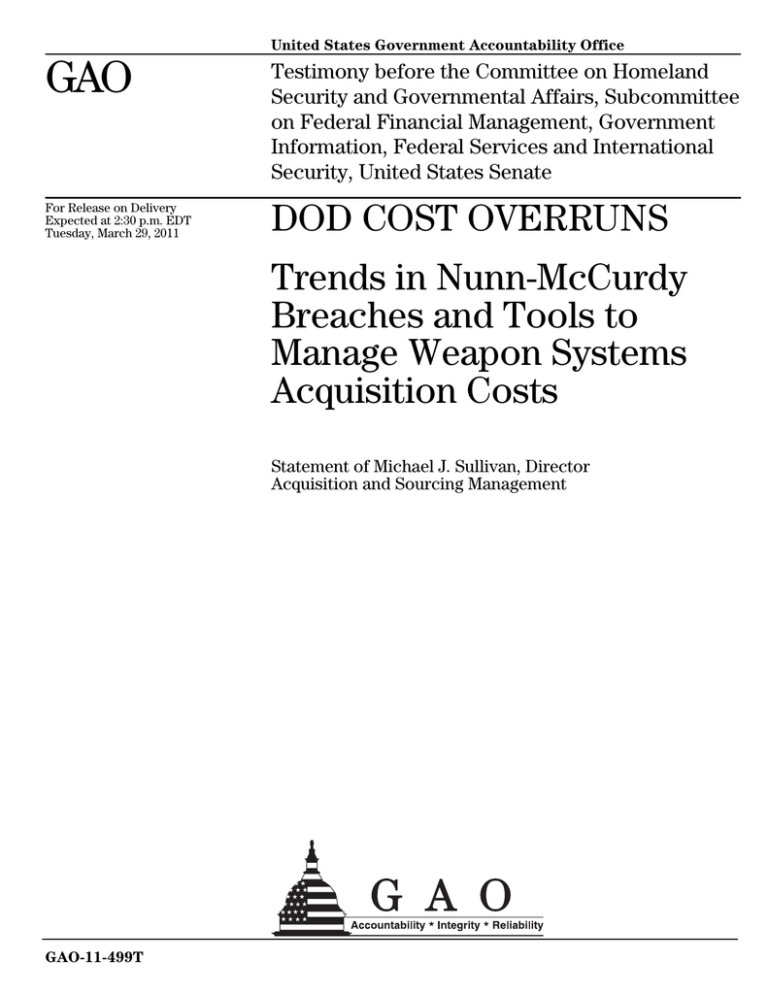
United States Government Accountability Office GAO Testimony before the Committee on Homeland Security and Governmental Affairs, Subcommittee on Federal Financial Management, Government Information, Federal Services and International Security, United States Senate For Release on Delivery Expected at 2:30 p.m. EDT Tuesday, March 29, 2011 DOD COST OVERRUNS Trends in Nunn-McCurdy Breaches and Tools to Manage Weapon Systems Acquisition Costs Statement of Michael J. Sullivan, Director Acquisition and Sourcing Management GAO-11-499T Mr. Chairman and Members of the Subcommittee: I am pleased to be here today to discuss tools available to minimize Department of Defense (DOD) cost overruns and our recent work on the Nunn-McCurdy process. For nearly 30 years, the statutory provision known as Nunn-McCurdy 1 has been a tool for Congress to use to hold DOD accountable for cost growth on major defense programs. The purpose of the statute was to provide Congress greater visibility into major defense programs’ cost growth and to encourage DOD to manage and control cost growth. A Nunn-McCurdy breach occurs when a program’s unit cost exceeds certain thresholds. When that happens, DOD must notify Congress of the breach. There are two types of Nunn-McCurdy breaches: significant breaches and critical breaches. 2 A breach of the significant cost growth threshold occurs when the program acquisition unit cost or the procurement unit cost increases by at least 15 percent over the current baseline estimate or at least 30 percent over the original baseline estimate. 3 A breach of the critical cost growth threshold occurs when the program acquisition unit cost or the procurement unit cost increases by at least 25 percent over the current baseline estimate or at least 50 percent over the original baseline estimate. The Nunn-McCurdy process has been amended a number of times over the years. For example, in the Weapon Systems Acquisition Reform Act of 2009, Congress enacted a new provision requiring the Secretary of Defense to terminate a program that 1 10 U.S.C. § 2433. The statutory provision is known as Nunn-McCurdy because it was first introduced by Senator Nunn and passed as a 1-year provision as part of the Department of Defense Authorization Act, 1982, 127 Cong. Rec. 9760-63 (1981), Pub. L. No. 97-86, § 917. The following year, Representative McCurdy introduced a permanent provision based on Senator Nunn’s provision, which was enacted as part of the Department of Defense Authorization Act, 1983, 128 Cong. Rec. 18345-48 (1982), Pub. L. No. 97-252, § 1107. There are a number of statutory provisions that help implement cost growth reporting under Nunn-McCurdy. For the purposes of this testimony, we refer to these statutory provisions as the Nunn-McCurdy process. 2 The Nunn-McCurdy statute did not use the terms “significant” or “critical” to describe the cost growth thresholds until 2006, when the statute was amended by section 802 of the National Defense Authorization Act for Fiscal Year 2006, Pub. L. No. 109-163. 3 Program acquisition unit cost is the total cost of development, procurement, acquisition operations and maintenance, and military construction divided by the number of units procured. Procurement unit cost is the total procurement cost divided by the number of units to be procured. Page 1 GAO-11-499T experiences a breach of the critical cost growth threshold, unless the Secretary of Defense submits a written certification to Congress. 4 My statement focuses on (1) trends in Nunn-McCurdy breaches, (2) factors that may be responsible for these trends, (3) changes DOD is making or proposing to make to the Nunn-McCurdy process, and (4) other tools DOD can use to minimize cost overruns. My testimony includes information from our March 2011 report on Nunn-McCurdy breaches, which is being released today. 5 The report contains information on the scope of our analysis and the methodology used. In addition, we drew on our published body of work on weapon system acquisitions and best practices to identify tools that can be used to minimize cost overruns. The work that supports this statement was performed in accordance with generally accepted government auditing standards. Those standards require that we plan and perform the audit to obtain sufficient, appropriate evidence to provide a reasonable basis for our findings and conclusions based on our audit objectives. We believe that the evidence obtained provides a reasonable basis for our findings and conclusions based on our audit objectives. Nunn-McCurdy Breaches Increased after Changes in Statute or Presidential Administration Since 1997, there have been 74 Nunn-McCurdy breaches involving 47 6 major defense acquisition programs. (See fig. 1.) There were a larger number of breaches in 2001, 2005, 2006, and 2009, which coincides with new statutory requirements or changes presidential administration. As a result of Congress requiring DOD to measure cost growth against the original baseline estimate, the number of breaches reported increased in 2005 and 2006. The number of breaches was also high in 2001 and 2009— the first years of new presidential administrations. During both transitions, no annual comprehensive Selected Acquisition Reports (SAR) were submitted, which, along with other factors, may have affected when 4 Weapon Systems Acquisition Reform Act of 2009, Pub. L. No. 111-23, § 206 (codified at 10 U.S.C. § 2433a(b)). 5 GAO, Trends in Nunn-McCurdy Cost Breaches for Major Defense Acquisition Programs, GAO-11-295R (Washington D.C.: Mar. 9, 2011). 6 See GAO-11-295R for more information about the methodology we used to count breaches and remove duplicate entries from data provided by DOD. Page 2 GAO-11-499T breaches were reported. 7 For example, according to DOD, during the transition from one administration to another in 2001, the cost of several programs breached Nunn-McCurdy thresholds because of a change in management philosophy, which included fully funding these programs to higher independent cost estimates. Figure 1: Critical and Significant Breaches by Calendar Year, 1997-2009 Type of breach 20 15 10 5 * 0 1997 1998 1999 2000 2001 2002 2003 2004 2005 2006 2007 2008 2009 Submission date Critical Significant Source: GAO analysis of DOD data. *No breaches were reported in 2000. Note: This figure uses the terms significant and critical to categorize reported program cost growth. We note, however, that prior to 2006, the statute did not use those terms to describe the cost growth thresholds. 7 DOD is required to submit SARs to Congress at the end of each fiscal year quarter on current major defense acquisition programs, although certain exceptions apply. SARs for the first quarter of a fiscal year are known as comprehensive annual SARs. Each comprehensive annual SAR is required to be submitted within 60 days after the date on which the President transmits the budget to Congress for the following fiscal year. 10 U.S.C. § 2432(b)(1), (c)(4), (f). While DOD is required to report breaches in quarterly SAR submissions, most breaches are typically reported in comprehensive annual SARs. Page 3 GAO-11-499T The Air Force had a higher proportion of total breaches compared to its proportion of total programs, whereas the Navy had a smaller proportion of breaches compared to its proportion of programs. Aircraft, satellite, and helicopter programs have experienced the largest number of breaches. Of the 47 programs that breached, 18 programs breached more than one time. Only one of the programs with multiple breaches—the Armed Reconnaissance Helicopter—was not recertified after a breach of the critical cost growth threshold and was terminated. The Navy Area Theater Ballistic Missile Defense was also not recertified and was terminated because of poor performance and projected future cost and schedule problems. Some programs that have experienced a critical breach— including the Advanced Seal Delivery System, Army Tactical Missile System-BAT, Comanche Reconnaissance Attack Helicopter, Land Warrior, and VH-71 Presidential Helicopter Replacement—have also been terminated. Engineering and Design Issues Are Most Cited by DOD as being Responsible for Nunn-McCurdy Breaches Nunn-McCurdy breaches are often the result of multiple, interrelated factors. Our analysis of DOD data and SARs showed that the primary reasons cited for the unit cost growth that led to Nunn-McCurdy breaches were engineering and design issues, schedule issues, and quantity changes. For example, we reported in 2003 that the Space Based Infrared System High program began with immature technologies and was based on faulty and overly optimistic assumptions about software reuse and productivity levels, the benefits of commercial practices, management stability, and the level of understanding of requirements. 8 The program has breached four times. A large number of programs that breached also cited revised estimates, due in part to changing assumptions; requirements changes; and economic changes, such as labor and overhead rates, as factors that contributed to the breaches. (See fig. 2.) For example, we previously reported that initial development cost estimates for the Army’s Warfighter Information Network-Tactical communications system were understated by at least $1.3 billion, or nearly 160 percent, as of July 2008, in part because the estimates assumed that commercial-off-the-shelf radio technology would be available. 9 This assumption proved to be wrong, and the program breached in 2006. 8 GAO, Defense Acquisitions: Despite Restructuring, SBIRS High Program Remains at Risk of Cost and Schedule Overruns, GAO-04-48 (Washington, D.C.: Oct. 31, 2003). 9 GAO, Defense Acquisitions: A Knowledge-Based Funding Approach Could Improve Major Weapon System Program Outcomes, GAO-08-619 (Washington, D.C.: July 2, 2008). Page 4 GAO-11-499T Figure 2: Factors Cited in SARs as being Responsible for Nunn-McCurdy Breaches Number of breaches citing this factor 60 50 50 44 41 40 38 35 34 30 23 21 20 16 10 uc t iss ion ue s Pr od nd iss ing ue s Fu pp o co rt sts Su ire ch men an t ge s qu Re on ch omi an c ge s Ec R es evis tim ed ate s Qu a ch ntit an y ge s Sc he d iss ule ue s En de gine sig er n i ing ss / ue s 0 Factors responsible for breaches Source: GAO analysis of DOD data. DOD Has Introduced New Practices to Mitigate Risk of Breaches and Plans to Propose Changes to Nunn-McCurdy Process DOD has instituted a process to provide earlier warning of potential NunnMcCurdy breaches and plans to propose changes to the Nunn-McCurdy process to reduce several statutory requirements for breaches caused by quantity changes. Specifically, the Joint Staff has implemented a process to provide an earlier evaluation of the factors that are contributing to cost growth so that programs can take mitigating actions before experiencing a significant Nunn McCurdy breach. This new process has merit, as our analysis shows that nearly 40 percent of Nunn-McCurdy breaches occurred after a production decision had been made—when a program has fewer options for restructuring. DOD plans to propose a legislative amendment to reduce several statutory requirements added in 2009 for Nunn-McCurdy breaches when it determines that a breach was caused primarily by quantity changes that were unrelated to poor performance. According to DOD, not Page 5 GAO-11-499T all breaches are indicators of poor performance because quantity reductions or capabilities added to a program after it begins can affect unit cost. DOD officials point to Excalibur as an example of a program that would qualify for this relief. The Excalibur program experienced a NunnMcCurdy breach of the critical cost growth threshold after the Army reduced quantities from 30,000 to 6,264. The quantity reductions were the result of Army assessments that concluded it did not need as many of these munitions as planned, rather than in response to program-specific cost concerns. While in the case of Excalibur the Army reduced quantities based on capability needs, we have previously reported that quantities are often reduced in response to cost overruns on programs. 10 Tracking changes in research and development costs, which are not sensitive to quantity changes, would be one way DOD could evaluate program performance in this context. Using KnowledgeBased Acquisition Practices Can Help Minimize the Risk of Cost Overruns The Nunn-McCurdy process can be a useful mechanism for holding programs accountable for cost growth and restructuring them in the wake of cost growth; however, its effect is limited because, in general, programs have already experienced significant problems by the time it is triggered. It is not realistic to expect cost growth to be entirely preventable, but it can be significantly reduced. To put programs in a position to minimize the risk of cost growth, DOD must use the tools available to it to establish programs in which there is a match between requirements and resources—including funding— from the start and execute those programs using knowledge-based acquisition practices. In our previous work, we have identified proven management practices—many of which have been incorporated into DOD policy, but have yet to be fully implemented in practice—that can serve as tools to prevent DOD cost overruns. 11 Greater adherence to the following practices at key phases of 10 GAO-08-619. 11 GAO, Best Practices: Better Management of Technology Development Can Improve Weapon System Outcomes, GAO/NSIAD-99-162 (Washington, D.C.: July 30, 1999); Best Practices: Better Matching of Needs and Resources Will Lead to Better Weapon System Outcomes, GAO-01-288 (Washington, D.C.: Mar. 8, 2001); Best Practices: Capturing Design and Manufacturing Knowledge Early Improves Acquisition Outcomes, GAO-02-701 (Washington, D.C.: July 15, 2002); GAO-08-619; Best Practices: DOD Can Achieve Better Outcomes by Standardizing the Way Manufacturing Risks Are Managed, GAO-10-439 (Washington, D.C.: Apr. 22, 2010); and Opportunities to Reduce Potential Duplication in Government Programs, Save Tax Dollars, and Enhance Revenue, GAO-11-318SP (Washington, D.C.: Mar. 1, 2011). Page 6 GAO-11-499T the acquisition process can help reduce weapon system costs, contain pressures for increased funding, and better address critical warfighter needs. • Early and continued systems engineering analysis: Early systems engineering, ideally beginning before a program is initiated and a business case is set, is critical to designing a system that meets requirements within available resources, such as technologies, time, money, and people. 12 Specifically, a robust analysis of alternatives and preliminary design review (PDR)—which analyze the achievability of required capabilities before committing to a program—can help ensure that new programs have a sound, executable business case that represents a cost-effective solution to meeting warfighters’ needs. Such engineering knowledge can identify key trade-offs in requirements and technology that are essential to managing cost. Systems engineering continues to be an important tool through a program’s critical design review (CDR) and system demonstration. • Leveraging mature technologies and processes: Programs often have insufficient knowledge about the maturity of technology. More prototyping early in programs could help DOD ensure that a system’s proposed design can meet performance requirements. Further, having predictable manufacturing processes before decisions are made to move into production can reduce unknowns. 13 • Establishing realistic cost and schedule estimates that are matched to available resources: Cost and schedule estimates are often based on overly optimistic assumptions. Our previous work shows that without the ability to generate reliable cost estimates, programs are at risk of experiencing cost overruns, missed deadlines, and performance shortfalls. 14 Inaccurate estimates do not provide the 12 GAO-01-288. 13 GAO-02-701. 14 GAO, GAO Cost Estimating and Assessment Guide: Best Practices for Developing and Managing Capital Program Costs, GAO-09-3SP (Washington, D.C.: March 2009). Page 7 GAO-11-499T necessary foundation for sufficient funding commitments. Engineering knowledge is required to achieve more accurate, reliable cost estimates at the outset of a program. • Clear, well-defined requirements: Our work has shown that DOD’s culture and environment often allow programs to start with too many unknowns, for example, entering the acquisition process without a full understanding of requirements. 15 Additionally, minimizing requirements changes could decrease the amount of cost growth experienced by acquisition programs. • Incremental approach to acquiring capabilities: Programs can put themselves in a better position to succeed by implementing incremental acquisition strategies that limit the time in development. 16 Our prior work on best product development practices found that successful programs use these tools as they progress through the acquisition process to gather knowledge that confirms that their requirements are achievable, their technologies are mature, their designs are stable, and their production processes are in control. Successful product developers ensure a high level of knowledge is achieved by key junctures in development. We characterize these junctures as knowledge points. The following figure depicts how these tools can come into play as a program moves through its development process and into production. It summarizes the activities necessary for successful outcomes at each key knowledge point. 15 GAO, Defense Acquisitions: Strong Leadership Is Key to Planning and Executing Stable Weapon Programs, GAO-10-522 (Washington, D.C.: May 6, 2010). 16 GAO-08-619. Page 8 GAO-11-499T Figure 3: DOD Acquisition Process and GAO Knowledge-Based Acquisition Practices DOD acquisition process Material development decision Material solution analysis Development start Milestone B Milestone A Production start Milestone C Engineering and manufacturing development Technology development Integrated system design PDR Best practices knowledge-based acquistion model: Capability and manufacturing demo Production CDR Knowledge point 1 Technologies, time, funding and other resources match customer needs Decision to invest in product development. Key steps: • Preliminary design review completed • Technologies demonstrated to high levels • Incremental acquisition strategy in place • Knowledge-based cost estimate Knowledge point 2 Design is stable and performs as expected. Decision to start building and testing production representative prototypes. Key steps: • System level critical design review and subsystem design reviews completed • Ninety percent of engineering drawings released • Integrated system prototype demonstrated Knowledge point 3 Production meets cost, schedule, and quality targets. Decision to produce first units for customer. Key steps: • Production-representative prototype demonstrated in intended environment • Manufacturing process in control • Product reliability demonstrated via production-representative prototype testing • Critical manufacturing process identified Source: GAO. Mr. Chairman, this completes my prepared statement. I would be happy to respond to any questions you or other members of the subcommittee may have at this time. Contacts and Acknowledgments (120979) For further information about this statement, please contact Michael J. Sullivan at (202) 512-4841 or sullivanm@gao.gov. Contact points for our Offices of Congressional Relations and Public Affairs may be found on the last page of this statement. Individuals who made key contributions to this statement include Ron Schwenn, Assistant Director; Morgan Delaney Ramaker; Kristine Hassinger; Leigh Ann Nally; Kenneth Patton; and Roxanna Sun. Page 9 GAO-11-499T This is a work of the U.S. government and is not subject to copyright protection in the United States. The published product may be reproduced and distributed in its entirety without further permission from GAO. However, because this work may contain copyrighted images or other material, permission from the copyright holder may be necessary if you wish to reproduce this material separately. GAO’s Mission The Government Accountability Office, the audit, evaluation, and investigative arm of Congress, exists to support Congress in meeting its constitutional responsibilities and to help improve the performance and accountability of the federal government for the American people. GAO examines the use of public funds; evaluates federal programs and policies; and provides analyses, recommendations, and other assistance to help Congress make informed oversight, policy, and funding decisions. GAO’s commitment to good government is reflected in its core values of accountability, integrity, and reliability. Obtaining Copies of GAO Reports and Testimony The fastest and easiest way to obtain copies of GAO documents at no cost is through GAO’s Web site (www.gao.gov). Each weekday afternoon, GAO posts on its Web site newly released reports, testimony, and correspondence. To have GAO e-mail you a list of newly posted products, go to www.gao.gov and select “E-mail Updates.” Order by Phone The price of each GAO publication reflects GAO’s actual cost of production and distribution and depends on the number of pages in the publication and whether the publication is printed in color or black and white. Pricing and ordering information is posted on GAO’s Web site, http://www.gao.gov/ordering.htm. Place orders by calling (202) 512-6000, toll free (866) 801-7077, or TDD (202) 512-2537. Orders may be paid for using American Express, Discover Card, MasterCard, Visa, check, or money order. Call for additional information. To Report Fraud, Waste, and Abuse in Federal Programs Contact: Congressional Relations Ralph Dawn, Managing Director, dawnr@gao.gov, (202) 512-4400 U.S. Government Accountability Office, 441 G Street NW, Room 7125 Washington, DC 20548 Public Affairs Chuck Young, Managing Director, youngc1@gao.gov, (202) 512-4800 U.S. Government Accountability Office, 441 G Street NW, Room 7149 Washington, DC 20548 Web site: www.gao.gov/fraudnet/fraudnet.htm E-mail: fraudnet@gao.gov Automated answering system: (800) 424-5454 or (202) 512-7470 Please Print on Recycled Paper
